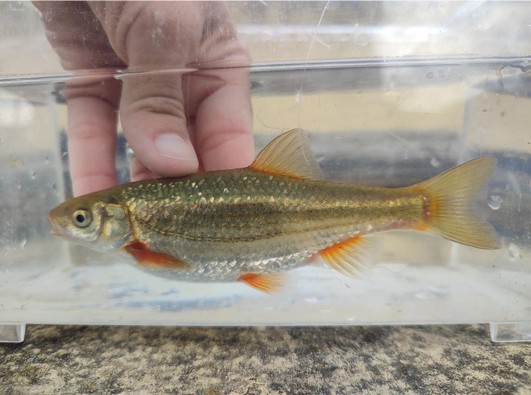The latest assessments by the International Union for Conservation of Nature (IUCN) Red List of Threatened Species confirm the progressive loss of biodiversity in freshwater ecosystems.
According to data published in the journal Nature, around a quarter of freshwater animal species are at risk of disappearing due to human pressure. This prospect is even more worrying in regions with a high degree of endemism, such as the Mediterranean, which is considered the second most important area in the world in terms of biodiversity. A total of 251 endemic species have already been recognised as threatened, of which some 72% face an extremely high or very high risk of extinction. (Red Book and National Information System for Continental Portugal’s Freshwater and Diadromous Fish).
Portugal’s endangered species
The assessment of the extinction risk of freshwater and diadromous migratory fishes in mainland Portugal reveals an alarming situation: 60% of the 43 native taxa are threatened according to IUCN criteria. Specifically:
- 6 taxa are critically endangered (CR), namely the Nabão lamprey, the Sado lamprey, the ruivaco-do-oeste, the Atlantic salmon, the sea trout and the river lamprey;
- 15 taxa are endangered (EN), including the allis shad, the jarabugo and the Portuguese bogue;
- 5 taxa are vulnerable (VU), such as the northern bogue and the common barbel;
- 5 taxa are Near Threatened (NT), such as river trout, southern barbel and northern bogue;
- The sturgeon (Acipenser sturio) is regionally extinct (RE).
Of the 10 Lusitanian endemics, only the ruivaco (Achondrostoma oligolepis) is not threatened (classified as of Least Concern, LC); the rest are at very high risk of extinction, with three classified as CR and six as EN. Of the 17 Iberian endemics, seven are threatened (four EN and three VU). Among the most widespread taxa, diadromous migratory fishes are the most affected, with seven taxa at risk, including three CR, two EN and two VU. In addition, three resident species (river lamprey, freshwater caboz and esgana-gata) are also classified as Vulnerable (VU).
This picture highlights the high vulnerability of Portuguese ichthyofauna, with particular attention to endemic and migratory species, many of which are in a critical situation.
Threats to Iberian fish fauna
Several simultaneous threats are jeopardising the survival of these species, making it imperative to understand the complexity of the environmental pressures affecting the region’s rivers and streams. According to the IUCN and recent scientific studies, the main threats to Iberian ichthyofauna are as follows
1. Water abstraction and hydrological infrastructure
Excessive water abstraction, especially in arid and semi-arid regions, has led to the fragmentation and reduction of aquatic habitats. The construction of dams and canals, while providing services for agriculture and domestic supply, causes irreversible changes in the water regime of rivers, with consequences for biodiversity.
The introduction of non-native species has led to the decline of native species through trophic interactions, hybridisation and the spread of disease. The negative effects of invasive species are exacerbated by habitat degradation.
3. Water pollution
Despite advances in wastewater treatment, pollution from heavy metals, pesticides and synthetic hormones remains a significant threat to freshwater fish, affecting water quality and the health of fish populations.
4. Alteration of riparian cover
Deforestation of riverbanks for urban and agricultural expansion has reduced the stability of aquatic ecosystems, altered water quality and compromised habitats essential for the reproduction and feeding of native species.
Climate change is exacerbating the effects of seasonal droughts, causing population fragmentation and increasing the vulnerability of fish species to extreme weather events.
Pathways for conservation
Faced with this alarming scenario, it is imperative to adopt integrated conservation measures that involve not only governments and scientists, but also local communities.
- Sustainable water management. Reducing excessive water abstraction and implementing efficient water use policies are essential to mitigate negative impacts on aquatic ecosystems.
- Control of invasive species. Strengthening legislation on the import and release of non-native species, together with programmes to eradicate invasive species, can help protect native biodiversity.
- Ecological restoration of riverbanks. Restoring riverbanks and reintroducing native vegetation can improve water quality and provide more suitable habitats for threatened fish species.
- Monitoring and reducing pollution. The development of more efficient wastewater treatment techniques and rigorous monitoring of pollution sources are essential to ensure water quality in freshwater ecosystems.
- Adapting to climate change. Implementing adaptation plans that take into account the resilience of aquatic ecosystems can minimise the impact of droughts and other extreme weather conditions.
The conservation of freshwater fish in Portugal and the Iberian Peninsula requires an urgent, multidisciplinary and coordinated response. The biodiversity of these ecosystems is an irreplaceable natural heritage, the loss of which will have a profound impact on the health of the environment, the economy and the quality of life of human populations. Protecting rivers means protecting the future.



